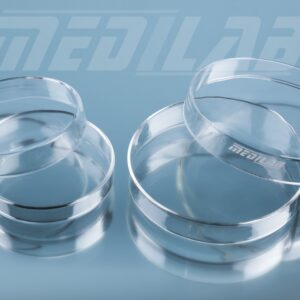Description
| Catalog No. | Capacity ml | Body Dia. | Neck Dia. | Height mm |
| 11007/1.1 | 25 | 51 | 26 | 90 |
| 11007/1 | 50 | 64 | 26 | 105 |
| 11007/1.2 | 150 | 74 | 28 | 115 |
| 11007/2 | 100 | 85 | 34 | 138 |
| 11007/3 | 250 | 93 | 34 | 143 |
| 11007/4 | 500 | 105 | 34 | 220 |
| 11007/5 | 1000 | 131 | 42 | 163 |
| 11007/6 | 2000 | 166 | 50 | 190 |
| 11007/7 | 3000 | 185 | 50 | 230 |
| 11007/8 | 5000 | 233 | 50 | 250 |
| 11007/9 | 10000 | 280 | 65 | 360 |
| 11007/10 | 20000 | 350 | 75 | 495 |
The MEDILAB Flat Bottom Narrow Neck Flask is a precision laboratory glassware item designed for heating, mixing, boiling, and temporary storage of liquids. Its flat base provides excellent stability on laboratory surfaces, while the narrow neck minimises evaporation and contamination. This flask is an essential tool in research, quality control, and industrial laboratories where accuracy, safety, and durability are critical.
Key Features
- Flat bottom design for stable placement on benches and hot plates
- Narrow neck to reduce spillage and evaporation loss
- High resistance to thermal shock and chemical attack
- Uniform wall thickness for safe and even heating
- Clear visibility for easy observation of contents
- Durable construction suitable for repeated laboratory use
Material Specifications
- Material Type: Premium laboratory-grade glass
- Thermal Properties: Excellent heat resistance for direct heating applications
- Chemical Resistance: Resistant to acids, alkalis, and most laboratory chemicals
- Mechanical Strength: Robust glass structure for long service life
- Standards Compliance: Manufactured in accordance with DIN / ISO laboratory glassware standards
Technical Specifications
- Available Capacities: As per the standard size table
- Shape: Flat bottom with narrow neck
- Graduation: Optional marking for approximate volume reference
- Accuracy Class: Not volumetrically calibrated (not for precise measurement)
- Accessories Included: Supplied without stopper (compatible stoppers available separately)
Handling & Precautions
- Use gradual heating to prevent thermal shock
- Avoid sudden temperature changes (hot to cold surfaces)
- Clean with mild laboratory detergents and soft brushes
- Suitable for autoclaving under standard laboratory conditions
- Do not use damaged or cracked glassware
- Store securely to prevent impact or tipping
Applications
- Chemical synthesis and solution preparation
- Heating, boiling, and mixing of liquids
- Pharmaceutical and biotechnology laboratories
- Academic research and university teaching labs
- Quality control (QC) and quality assurance (QA) testing
- Routine laboratory workflows in industrial and analytical settings







